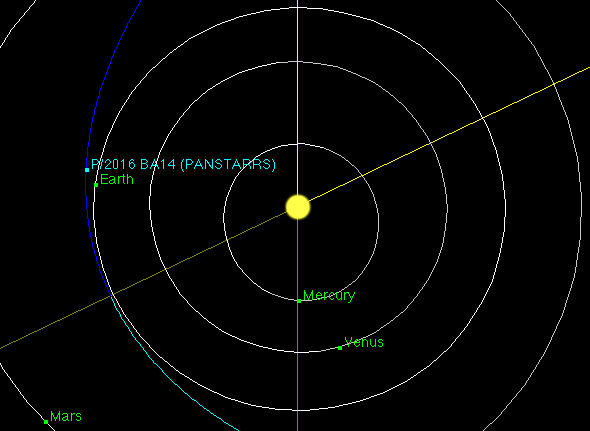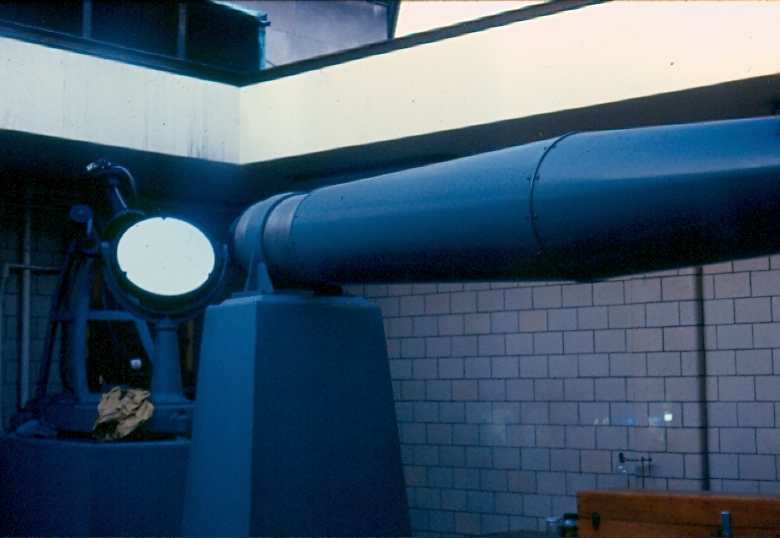
Comet P/2016 BA14 (Pan-STARRS) will make a safe but extremely close pass of Earth on March 22nd.
NASA / JPL
- See more at:
http://www.skyandtelescope.com/observing/p2016-ba14-closest-comet-in-almost-250-years03162016/#sthash.KgXD06pg.dpufNASA / JPL

Comet P/2016 BA14 (Pan-STARRS) will make a safe but extremely close pass of Earth on March 22nd.
NASA / JPL
- See more at:
http://www.skyandtelescope.com/observing/p2016-ba14-closest-comet-in-almost-250-years03162016/#sthash.KgXD06pg.dpufNASA / JPL

Comet P/2016 BA14 (Pan-STARRS) will make a safe but extremely close pass of Earth on March 22nd.
NASA / JPL
- See more at:
http://www.skyandtelescope.com/observing/p2016-ba14-closest-comet-in-almost-250-years03162016/#sthash.KgXD06pg.dpufNASA / JPL

Comet P/2016 BA14 (Pan-STARRS) will make a safe but extremely close pass of Earth on March 22nd.
NASA / JPL - See more at: http://www.skyandtelescope.com/observing/p2016-ba14-closest-comet-in-almost-250-years03162016/#sthash.KgXD06pg.dpuf
On March 22, Comet P/2016 BA14 (Pan-STARRS) will pass the Earth at a safe, butNASA / JPL - See more at: http://www.skyandtelescope.com/observing/p2016-ba14-closest-comet-in-almost-250-years03162016/#sthash.KgXD06pg.dpuf
extremely close, distance.
(Image Sources: NASA, Jet Propulsion Laboratory / California Institute of Technology,
Sky and Telescope Magazine)
By Glenn A. Walsh
Reporting for SpaceWatchtower
On the first two full days of Spring
(March 21 and 22) two, possibly related, comets will pass very close to
the Earth. The second and smaller of the two comets is predicted to become the second closest comet to ever approach the Earth.
The day before the first comet fly-by, March 20, marks the beginning of Spring. And, there is now an effort to have the day of the Vernal Equinox designated to commemorate the life of the first female astronomer, Hypatia of Alexandria, in ancient Egypt.
This will be the first time two comets have come close to the Earth only a day apart. Scientists are eagerly awaiting their arrival, hoping to learn much more about the nature of comets. In fact, the Hubble Space Telescope and several ground-based telescopes will be used to watch these two comets as they fly by our planet.
The day before the first comet fly-by, March 20, marks the beginning of Spring. And, there is now an effort to have the day of the Vernal Equinox designated to commemorate the life of the first female astronomer, Hypatia of Alexandria, in ancient Egypt.
This will be the first time two comets have come close to the Earth only a day apart. Scientists are eagerly awaiting their arrival, hoping to learn much more about the nature of comets. In fact, the Hubble Space Telescope and several ground-based telescopes will be used to watch these two comets as they fly by our planet.
The first of the two comets, Comet 252P
/ LINEAR, will probably be the brightest comet, but it will not come
the closest to Earth. This comet will come within about 3.3 million
miles / 5.3 million kilometers of our planet on March 21, which will still make it
one of the ten closest comets to ever approach the Earth. But, this
is not real close, considering that the Earth's Moon, on average, is
238,855 miles / 384,400 kilometers from our planet.
During the last weeks of March, Comet
252P / LINEAR will be primarily visible in the Southern
Hemisphere—perhaps even naked-eye visibility, but only away from
city lights. In North America, binoculars will probably be needed to
see this comet, but, again, you need to be away from city lights. And, remember such observations are always weather-permitting. At
the end of this blog post there will be a link to an article from Sky
and Telescope Magazine, which includes two star charts for finding
this comet during the last weeks of March and the beginning of April.
This comet was not expected to be this
bright, but amateur astronomers have noticed it brightening more
rapidly than expected. According to University of Maryland's Matthew
Knight, Comet 252P / LINEAR has a bright emerald-green color, from carbon
gas emanating from the comet.
Internet Links to Additional Information
Sky and Telescope Article with Star Charts for Finding Comet 252P / LINEAR (one star chart is half-way down the page; another star chart is near the end of the article):
The second comet, trailing Comet 252P
/ LINEAR, was quite a surprise. At first they thought this object was
an asteroid, until Matthew Knight discovered the object had a tail.
Designated Comet Pan-STARRS P / 2016 BA14, both comets seem to have
the same path through the Solar System. Hence, it is conjectured that
both comets may have originated from the same single comet.
On March 22 at about 12:00 Noon Eastern Daylight Saving Time (EDT) /
16:00 Coordinated Universal Time (UTC) Comet P / 2016 BA14 is expected to become the second
closest comet to ever approach Earth, when it comes within 2.1 mllion
miles / 3.4 million kilometers of Earth. However, despite coming
closer to Earth, this comet is dimmer, and a telescope will be needed
to see it.
Lexell's Comet was the closest comet to
ever approach the Earth. This comet came within 1.4 million miles /
2.2 milion kilometers of our planet on 1770 July 1. Although actually
discovered by famous astronomer Charles Messier, it became popularly
known as Lexell's Comet after the comet's orbit was calculated by
astronomer and mathematician Anders Johan Lexell.
For a time during the 20th
century, the Comet of 1491 was considered the closest comet to ever
come near the Earth, at 873,784 miles / 1,406,219 kilometers from the
Earth. However, Japanese researcher Ichiro Hasegawa, of the Faculty
of Socio-Cultural Studies at Otemae University retracted this claim
in 2002, saying "The orbital elements for Comet 1491 II = C /
1491 B1 (Hasegawa 1979) are to be retracted, because the records of
this comet were misunderstood."
The
season of Spring, in Earth's Northern Hemisphere,
begins at the Vernal Equinox: early Sunday Morning, 2016 March 20 at
12:30 a.m. EDT / 4:30 UTC --- the time of the posting of this blog post. And this year, Spring begins on Palm
Sunday, the
beginning of Holy Week in the Christian faith.
In the Southern Hemisphere, this marks the astronomical beginning of the season of Autumn.
In the Southern Hemisphere, this marks the astronomical beginning of the season of Autumn.
This year, Spring arrives earlier than
any previous year since 1896! In fact, ever since the year 2000,
which was a leap year (unlike the year 1900 which was not a leap year
and the year 2100 which will not be a leap year, due to Pope
Gregory's calendar reform of 1582), the Vernal Equinox of each
succeeding leap year in the 21st century will be earlier
than that of the previous leap year!
These earlier Vernal Equinoxes during
the 21st century are due to the difference between the
Tropical Year or Solar Year (whch is measured from the time of the
Vernal Equinox of one year to the time of the Vernal Equinox of the
next year: 365.242 days) and the common calendar year of an even 365
or 366 days. The earliest Vernal Equinox of the 21st
century will occur on 2096 March 19 at 10:03 a.m. EDT / 14:03 UTC.
The Vernal Equinox is used in the solar
calendars of Iran and Afghanistan as the beginning of their calendar
year. In ancient times, the Vernal Equinox, then celebrated by the
old style calendar on or near March 25, was also the beginning of the
calendar year for many ancient civilizations.
The Vernal Equinox is also the first day of the National Cherry Blossom Festival held each year in Washington, DC. This festival commemorates the 1912 gift of 3,000 cherry trees from the Mayor of Tokyo to the City of Washington. The festival runs through April 17 this year.
The Vernal Equinox is also the first day of the National Cherry Blossom Festival held each year in Washington, DC. This festival commemorates the 1912 gift of 3,000 cherry trees from the Mayor of Tokyo to the City of Washington. The festival runs through April 17 this year.
Physicians have
declared the first week of Spring as Medicine Cabinet Clean-Up Week.
They urge families, as part of their annual Spring cleaning, to
clean-out the medicine cabinet of old and expired pharmaceuticals
which are no longer being used. This would prevent other family
members from using these old drugs by accident, or the beginning of
drug abuse.
Astronomical
historian Ari Belenkiy, who just finished an academic paper on the
life and death of the first female astronomer, Hypatia of Alexandria,
has started an effort to have the day of the Vernal Equinox, March
20, designated as a day commemorating Hypatia's life.
Hypatia was a
Greek astronomer, mathematician, and philosopher, daughter of the
mathematician Theon Alexandricus, who lived in Alexandria, Egypt
during the late 4th and early 5th centuries. At
that time Alexandria was part of the Eastern Roman Empire, which had
a great rivalry with the Church of Rome. This led to deep divisions
in Alexandria.
Due to the fog of
time, there is much dispute regarding the events surrounding the
death of Hypatia. According to the Church historian Socrates Scholasticus, a clique of Bishop Cyril's zealots
killed Hypatia, due to a deep conflict between the Governor and
Bishop of Alexandria. Hypatia's astronomical calculations regarding
the date of Easter may have set the mob against her.
Although none of
Hypatia's writings survive, she is reported to have made significant
academic contributions in the fields of Astronomy and Mathematics.
Internet Links to Additional Information
Link >>> http://www.skyandtelescope.com/observing/p2016-ba14-closest-comet-in-almost-250-years03162016/
More on the Vernal Equinox ---
Link 1 >>> http://scienceworld.wolfram.com/astronomy/VernalEquinox.html
Link 2 >>> https://en.wikipedia.org/wiki/March_equinox
More on the Season of Spring: Link >>> https://en.wikipedia.org/wiki/Spring_%28season%29
More on the Gregorian Calendar Reform of 1582:
Link >>> https://en.wikipedia.org/wiki/Gregorian_calendar
More on Medicine Cabinet Clean-Up Week:
Link >>> http://www.pamedsoc.org/FunctionalCategories/About/Media/Medicine-Cabinets-Spring-Cleaning.html
More information on the National Cherry
Blossom Festival:
More about Hypatia ---Link 1 >>> https://en.wikipedia.org/wiki/Hypatia
Link 2 >>> http://booksandjournals.brillonline.com/content/journals/10.1163/15700720-12341264
More on the petition to designate March 20 to commemorate the life of Hypatia:
Link >>> https://www.change.org/p/canada-s-parliament-commemorating-the-first-female-astronomer-hypatia-of-alexandria
Related Blog Post ---
"Comet of 1491: Self-Correction of Science." 2016 Feb. 20.
Link >>> http://spacewatchtower.blogspot.com/2016/02/comet-of-1491-self-correction-of-science.html
Source: Glenn A. Walsh Reporting for SpaceWatchtower, a project of Friends of the Zeiss.
2016 March 20.

2016: 75th Year of Pittsburgh's Buhl Planetarium Observatory
Link >>> http://buhlplanetarium2.tripod.com
Like This Post? - Please Share!
Want to receive SpaceWatchtower blog posts in your inbox ?
Send request to < spacewatchtower@planetarium.cc >..
gaw
Glenn A. Walsh, Project Director,
Friends of the Zeiss < http://buhlplanetarium.tripod.com/fotz/ >
Electronic Mail - < gawalsh@planetarium.cc >
SpaceWatchtower Blog: < http://spacewatchtower.blogspot.com/ >
Also see: South Hills Backyard Astronomers Blog: < http://shbastronomers.blogspot.com/ >
Barnestormin: Writing, Essays, Pgh. News, & More: < http://www.barnestormin.blogspot.com/ >
About the SpaceWatchtower Editor / Author: < http://buhlplanetarium2.tripod.com/weblog/spacewatchtower/gaw/ >
SPACE & SCIENCE NEWS, ASTRONOMICAL CALENDAR:
< http://buhlplanetarium.tripod.
Twitter: < https://twitter.com/spacewatchtower >
Facebook: < http://www.facebook.com/pages/
Author of History Web Sites on the Internet --
* Buhl Planetarium, Pittsburgh:
< http://www.planetarium.
* Adler Planetarium, Chicago:
< http://adlerplanetarium.
* Astronomer, Educator, Optician John A. Brashear:
< http://johnbrashear.tripod.com >
* Andrew Carnegie & Carnegie Libraries:
< http://www.andrewcarnegie.
* Civil War Museum of Andrew Carnegie Free Library:
< http://garespypost.tripod.com >
* Duquesne Incline cable-car railway, Pittsburgh:
< http://inclinedplane.tripod.
* Public Transit:
< http://andrewcarnegie2.tripod.
No comments:
Post a Comment